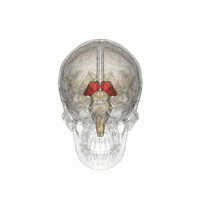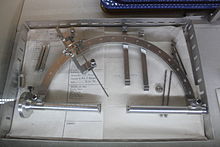Thalamotomy
| Thalamotomy | |
|---|---|
 Thalamus | |
| ICD-9-CM | 01.41 |
Thalamotomy (Greek: θάλαμος, romanized: thalamus, lit. 'chamber'; Greek: τομή, romanized: tomē, lit. 'cut, slice') is a surgical procedure in which a functional lesion is made into the thalamus to improve the overall brain function in patients. First introduced in the 1950s, it is primarily effective for tremors such as those associated with Parkinson's disease, where a selected portion of the thalamus is surgically destroyed (ablated). Neurosurgeons use specialized equipment to precisely locate an area of the thalamus, usually choosing to work on only one side (the side opposite that of the worst tremors). Bilateral procedures are poorly tolerated because of increased complications and risk, including vision and speech problems. The positive effects on tremors are immediate. Other less destructive procedures are sometimes preferred, such as subthalamic deep brain stimulation, since this procedure can also improve tremors and other symptoms of PD.[1][2][3]
Indications
Thalamotomy is a complex procedure performed by specialist neurosurgeons. It is mostly indicated in cases of stroke, damage to third ventricle of brain, brain hemorrhage, accidents leading to head injury, oedema around thalamus, subdural hemorrhage, and cerebrovascular accident. There is also some evidence in thalamocortical dysrhythmia.
Subthalamotomy
Subthalamotomy is a type of brain surgery in which the
Surgical procedures

Thalamotomy can be performed in an invasive or noninvasive manner. If performed invasively, then prior to the operation, a
Complications
Some of the patients in Cuban studies developed complications from the surgery, including severe involuntary movements, but the symptoms abated (to the point where patients could tolerate them) after three to six months.[5] Most common complications include a risk of stroke, confusion, and speech and/or visual problems.[8] Although risks exist with unilateral subthalamotomy, they are greatly increased with bilateral subthalamotomy.
Studies
One study followed 89 patients with PD who were treated with unilateral subthalamotomy. Sixty-eight patients were available for evaluations after 12 months, 36 after 24 months, and 25 after 36 months. The Unified Parkinson’s Disease Rating Scale motor scores improved significantly and levodopa daily doses were significantly reduced by 45, 36, and 28% at 12, 24 and 36 months after surgery. Unilateral subthalamotomy was associated with significant motor benefit contralateral to the lesion. Further work is needed to ascertain what factors led to severe, persistent chorea-ballism in a subset of patients.[9] In an earlier study, 18 advanced PD patients received staged or simultaneous bilateral one or more subthalamotomy. One patient subsequently developed multiple system atrophy signs and was excluded from further analysis. Motor improvements compared to baseline were 58% in the off state and 63% in the on state. Daily levodopa dose was reduced by a mean of 72%, with five patients receiving none. Three patients developed severe chorea postoperatively, which improved spontaneously at 3–6 months.[10] In a third study, microelectrode mapping (guided stereotactic surgery on the subthalamic nucleus) was performed in eight patients with PD, and the findings indicated that subthalamotomy can ameliorate the cardinal symptoms of PD, reduce the dosage of levodopa, diminish complications of the drug therapy, and improve the quality of life.[11] Havana’s International Center for Neurological Restoration reported at the American Neurological Association meeting in October 2002 that two years after undergoing a bilateral dorsal subthalamotomy, 17 Cuban patients improved by an average of 50% on movement tests, and they could dramatically reduce their daily ingestion of levodopa.[5]
Subthalamotomy could be a preferred option for people with PD who have trouble affording either the medication or
References
- S2CID 2042799.
- S2CID 34923492.
- S2CID 23274820.
- ^ Sub-thalamotomy. National Parkinson Foundation. Retrieved from "National Parkinson Foundation - Subthalamotomy". Archived from the original on 2012-09-06. Retrieved 2012-05-01.
- ^ a b c d Stix, Gary. (2003). Sustainable Surgery. Scientific American. Retrieved from http://www.scientificamerican.com/article.cfm?id=sustainable-surgery
- ^ a b Subthalamotomy. BootsWebMD. Retrieved from http://www.webmd.boots.com/a-to-z-guides/parkinsons-disease-subthalamotomy
- PMID 26421209.
- ISBN 978-1-84257-657-1.
- PMID 19204026.
- PMID 15689366.
- PMID 12296644.
